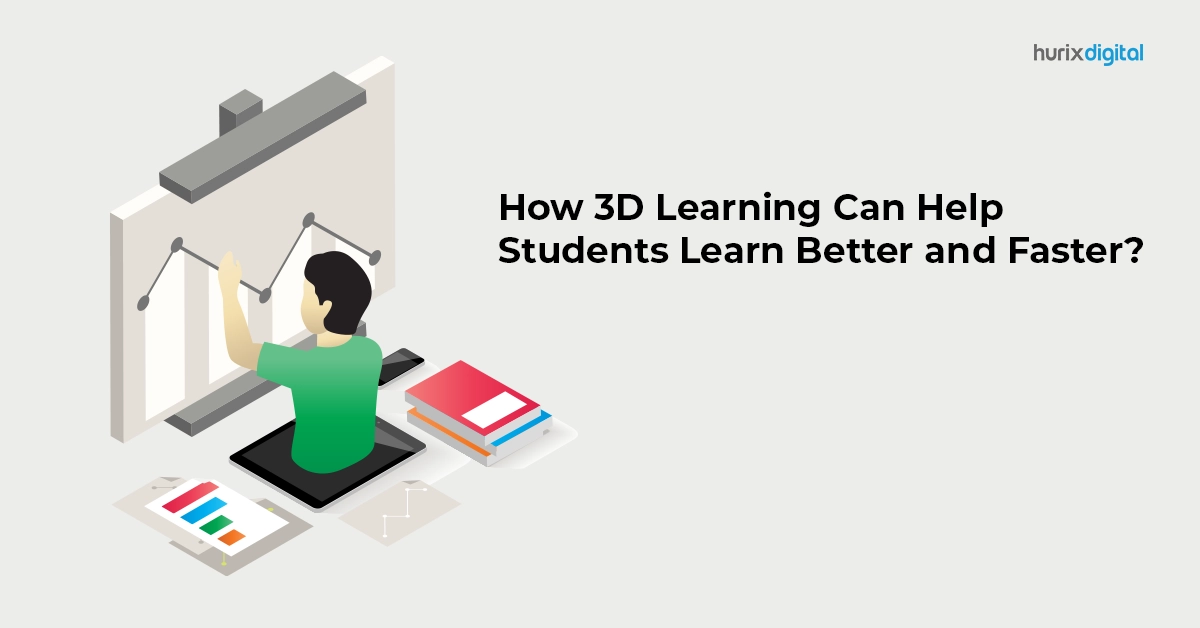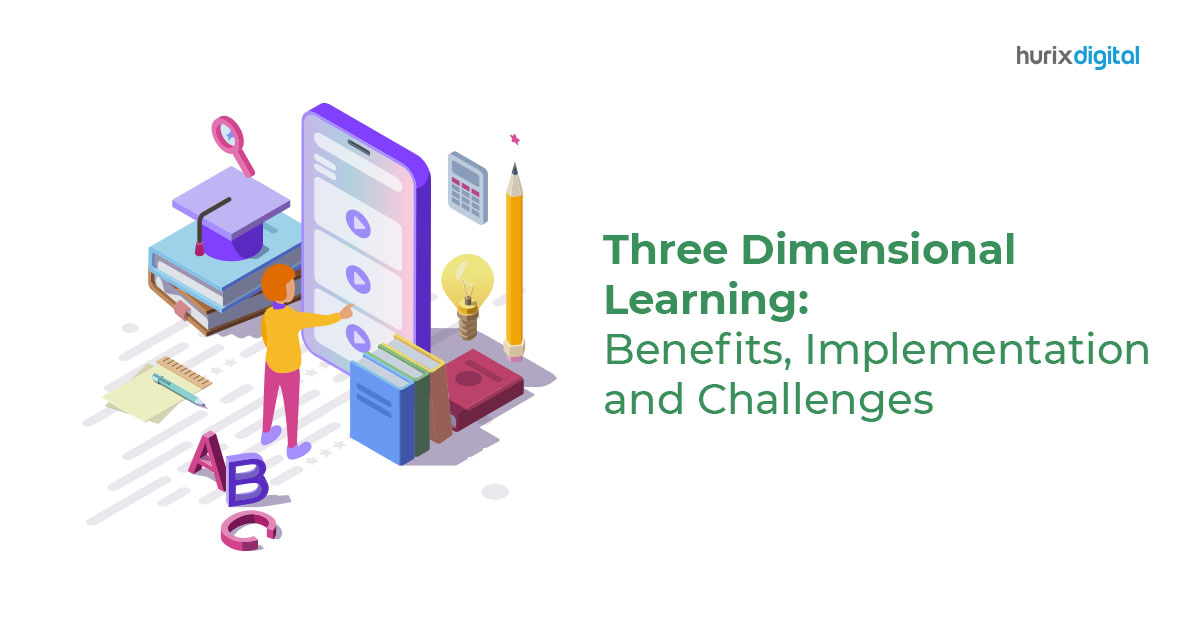
How 3D Learning Can Help Students Learn Better and Faster?
Summary
Learn how D-learning (Digital Learning) can improve student learning outcomes by providing flexible, engaging, and personalized learning experiences.
The process of learning and upskilling is undergoing tremendous transformation. Education providers, from institutes to platforms, are investing in making education more engaging.
Learning is no longer a one-dimensional, one-way street via classroom lectures. It is more interactive and immersive. Learners seek an experience, as opposed to classroom lectures. More learners are also leveraging smart devices, particularly mobile, to learn more often and more effectively.
In 2019, the global e-learning market was valued at around USD 200 billion and is expected to reach USD 400 billion by 2026. Three-dimensional learning, or 3D learning, will play a major role in this growth curve.
In this blog, we delve into the growing relevance of 3D learning in contemporary e-learning and showcase how it caters to learning aspirations and effectiveness in educational and upskilling contexts.
Table of Contents:
- What is 3D Learning?
- Why is 3D Learning Relevant Today?
- Top Advantages of 3D Learning
- The Conclusion
What is 3D Learning?
3D learning leverages state-of-the-art three-dimensional technology that helps bring real-life depth to any visualization. It is used at various levels of education, as well as skill-building, to simulate complex concepts and make the absorption of learning fundamentals easier. It is not to be confused with 3D printing learning, which offers programs to help designers and other professionals simplify the production process with the help of 3D printing.
For instance, the visualization of the human heart is an example of a 3D education-driven approach. A 3D rendition of the heart can help biology students understand more effectively how this organ looks and works. A stunning 3D visualization can instantly help students absorb and memorize the solar system’s appearance rather than merely reading about it in a textbook.
3D training is also being harnessed in areas such as IT to help students pick up the fundamentals faster and build new skills such as coding. Learning skills such as driving is another functional use of 3D learning to help learners easily absorb rules and fundamentals.
The sheer demand for 3D learning has given rise to more professionals wanting to learn 3D modeling and thrive in this industry.
Also Read: Revolutionizing eLearning: The Benefits of 3D Modeling and Animation in Course Development
Why is 3D Learning Relevant Today?
Today, the spectrum of learners has also grown. Learners are not only those pursuing formal education in schools or colleges. More learners are building skills and are registered for unconventional subjects such as creative writing, and they may pursue learning alongside a job or as part of corporate training. Many students are also left outside the formal education system due to various learning challenges, from facing geographical barriers to having a disability.
Hence, the modern learner profile is more diverse. 3D learning is growing in popularity as a format that appeals to and is useful to a diverse student body. Learning can be done independently, without the intervention of a trainer or teacher. This flexibility enables a wider range of learners to achieve a holistic education.
Top Advantages of 3D Learning
3D learning has several benefits, elevating the effectiveness and quality of education and training. Here is a snapshot of the advantages:
1. Simplifies the Learning Process
3D learning visualizations can simplify and build engaging content across a wide range of subjects, from science and technology to skill building. Learners need to rely less on imagination and can visualize concepts in their textbooks. They can also revise concepts by watching short 3D video content anytime, anywhere.
2. Makes Learning More Accessible
Learners who cannot attend physical lectures or have learning challenges can fill the gaps with access to high-quality 3D learning content. The content is easy to access online and shared by teachers and facilitators.
3. Builds Valuable On-Demand Resources
Many learners prefer to learn flexibly and on their own time today. 3D learning visualizations can enhance the quality of on-demand resources and be accessible at any time of the day.
This is not the case when pedagogy only comprises live instruction, which is location-centric. On the other hand, 3D learning content can be accessed from any geography at any time. It is especially useful for learners in remote locations or those who attend virtual schools. It makes learning more engaging.
4. Easy to Blend with Other Formats
3D is a versatile technology. When used in a learning context, it can be integrated with other content formats and technologies such as artificial intelligence, gamification, live interactive simulations, and eBooks, which are gaining popularity over physical textbooks.
For instance, 3D learning in education can comprise a Physics textbook, which hyperlinks 3D learning videos to concepts such as Newton’s laws. Modern eBooks enable content to be easily bookmarked, shared, and highlighted.
5. 3D Learning is Easy to Adapt to Micro-Learning
There is a growing trend of learners wanting to learn from mobile phones. Content is developed in byte-sized pieces, thus earning the name micro-learning. As younger generations grow up with easy access to a smartphone, it will be important for learning content to be made accessible for mobile. 3D learning is easy to adapt to mobile learning, as visualizations can be viewed easily. Moreover, 3D visuals can be more engaging and effective than reading large chunks of text on a small screen.
Also Read: How To Use Gamification In Your Corporate Microlearning?
In Conclusion
The traditional pedagogy of lecture style has limitations in the modern world. With more users getting onto the internet, learners today want more flexibility in the learning process. They also want a more interactive, immersive experience that is accessible from the comfort of their smartphones. 3D learning checks all these boxes and has massive potential to make learning affordable and effective.
Today, education providers can curate high-quality 3D learning content and distribute it securely by leveraging a digital publishing suite. The effectiveness of learning modules can also be tracked. This single, unified platform enables content to be created per a learner’s real-time needs.
If your business is looking to build 3D learning into your education or training modules, Hurix Digital is geared to support you in meeting all your learning management needs through a state-of-the-art Learning Management System (LMS).
Get in touch with us to start a conversation and leverage the best LMS solutions for your small business.

Performance, Results, Growth, and Life-Long Learning define my professional life. I am passionate about making workplace learning planful, purposeful, and impactful. I take pride in partnering with clients and bringing them the best in learning design and creating solutions that address business challenges.






